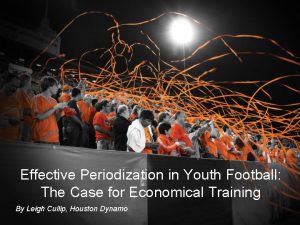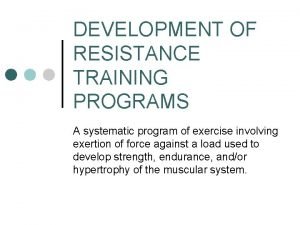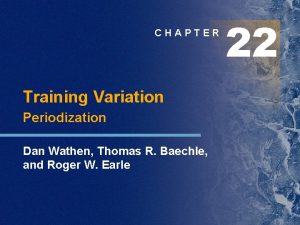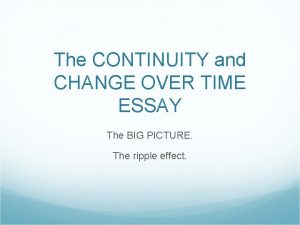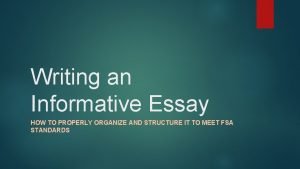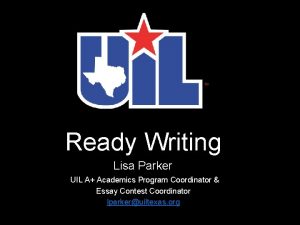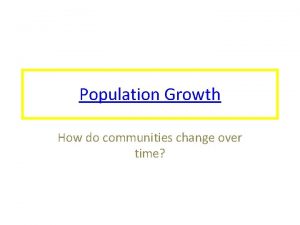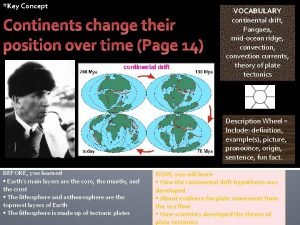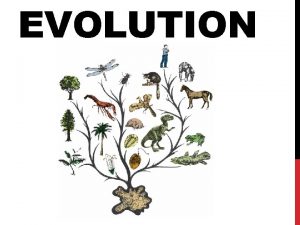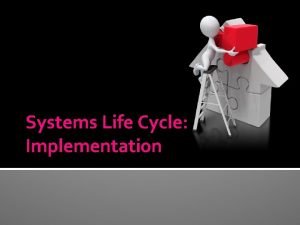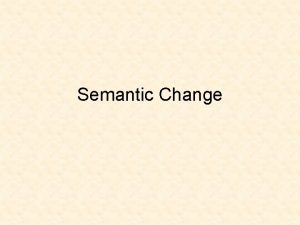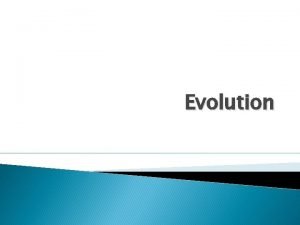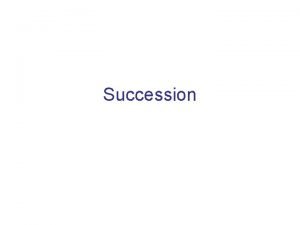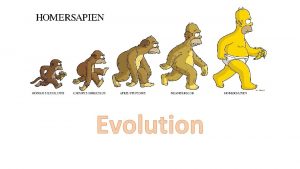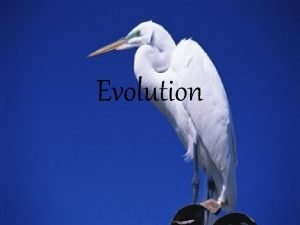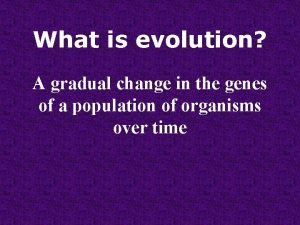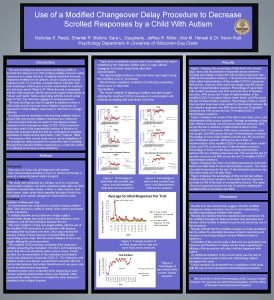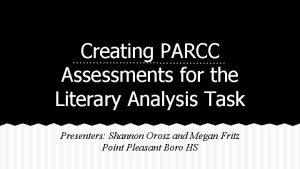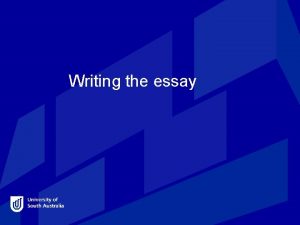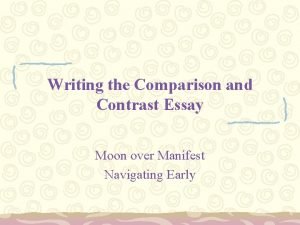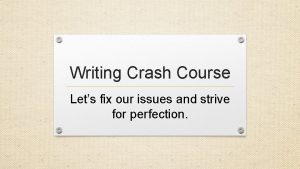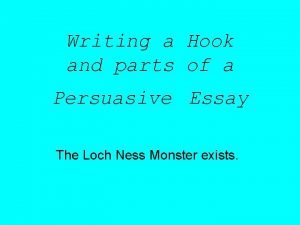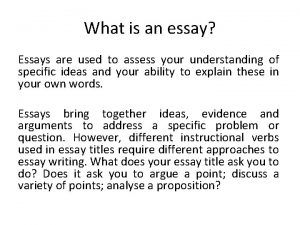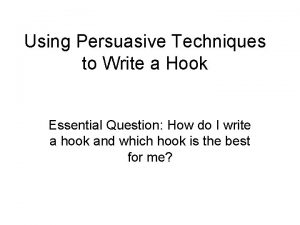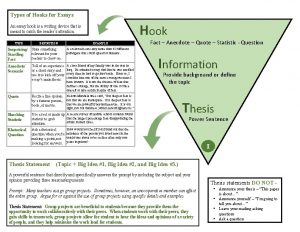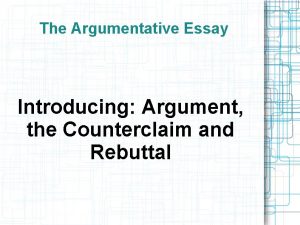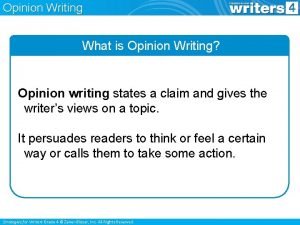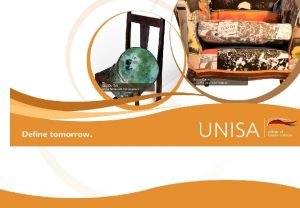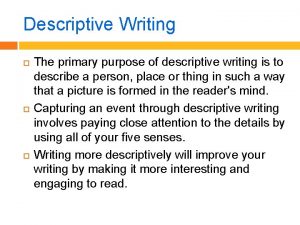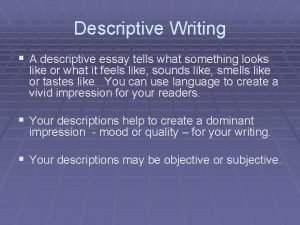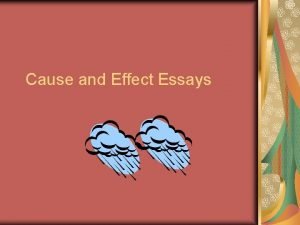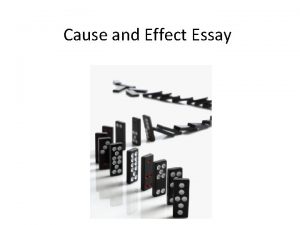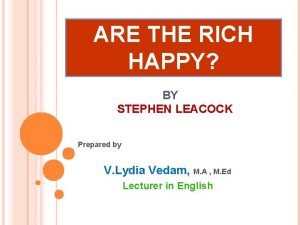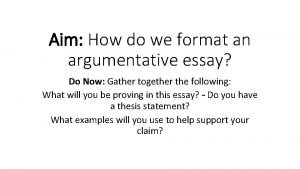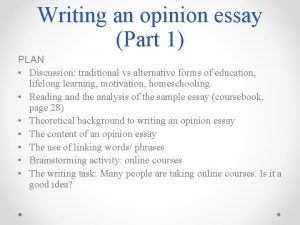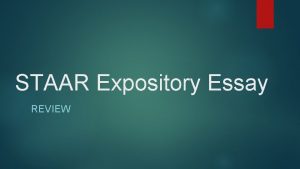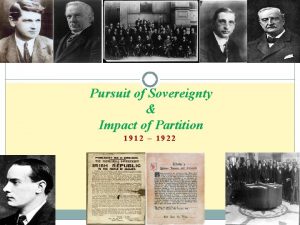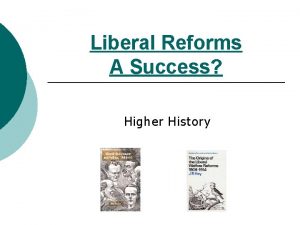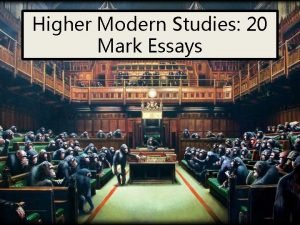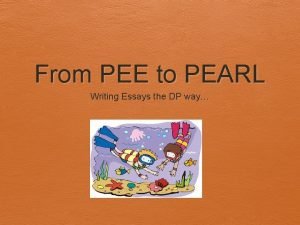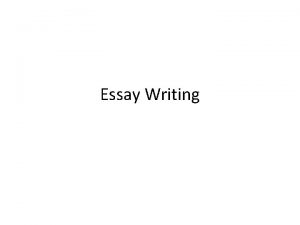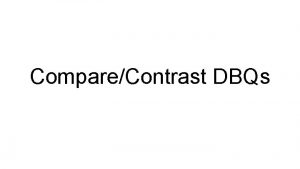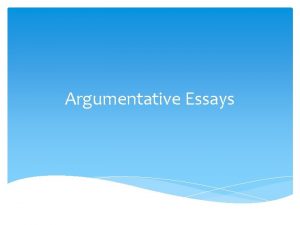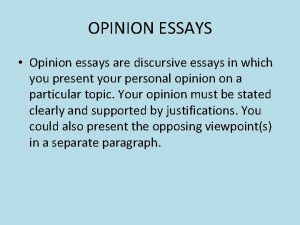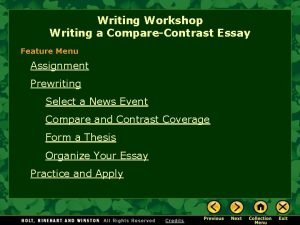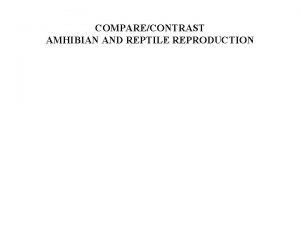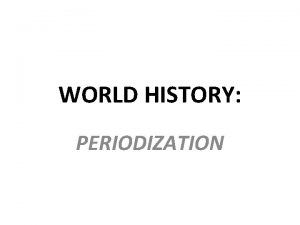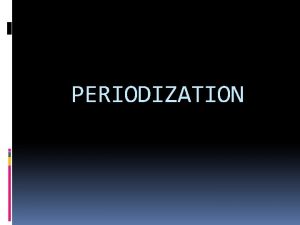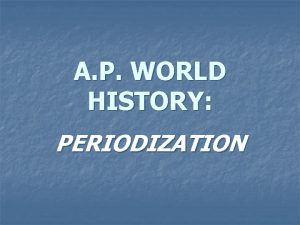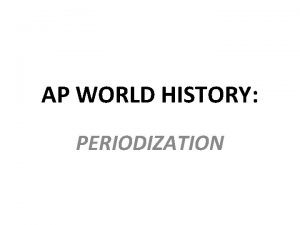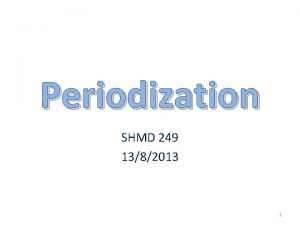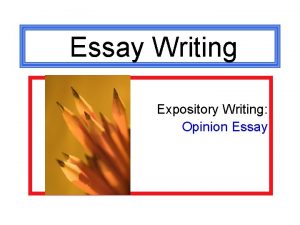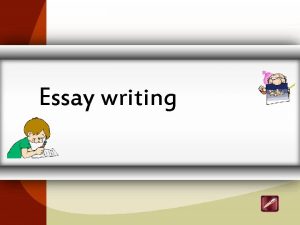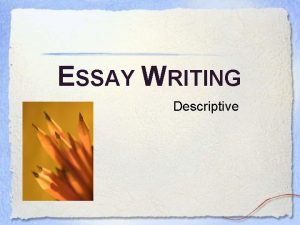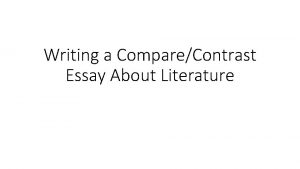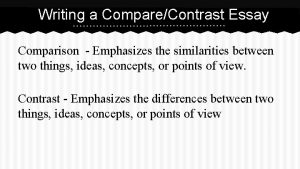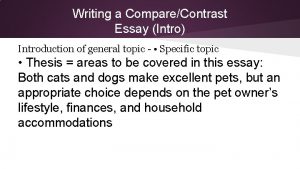Essay Writing 4 Essays CompareContrast Periodization Change over

































































- Slides: 65

Essay Writing

4 Essays • • Compare/Contrast Periodization Change over time Document Based Questions

Compare and Contrast Essay Thesis Statements The College Board has a very specific view of an acceptable thesis statement for each of it’s types of essays Compare and Contrast: Thesis sentence must contain the two civilizations your contrasting, the time if given, and any question specific words. Also: One similarity and one difference, in a specific topic. (they must be directly comparable)

Ex. Question: Based off of the time period 3, 000 BCE to 600 BCE, compare and contrast Egypt and Sumer’s political, economic, and social structure. The Ancient civilizations of Egypt and Sumer (3, 000 to 600 BCE) are similar in that their economics are rooted in the traditional practices of farming and trade, and that their social structure demonstrated emerging social division, however they differed in that Sumer was organized into city-states and Egypt became a centralized empire.

Make sure you NAME THE DIFFERENCES for both civilizations • Ex. *Wrong* China and India differ in the intensity of religious worship. • Ex. *Right* China and India differ in that in China religious practice was more philosophical and in India it was more spiritual.

What to do avoid to get a “sophisticated” Thesis • These words – Social – Political – Economic • Instead…be specific – Social = slavery – Economic = trade – Political = invasion

Little Better In the time of the ancients (3, 000 BCE to 600 BCE) the civilizations of Egypt and Sumer are similar in that their trade was limited and mostly consisted of agricultural goods, and that they each developed a polytheistic faith, however they differed in the formation of their states that Sumer was organized into city-states and Egypt became a centralized empire.

Moar! Examples Question: How did the political structure of Han and Roman empire differ?

2010 COMPARE/CONTRAST THESIS During the classical period, there were many similarities and differences between the methods of political control in the empires of Han China and imperial Rome. They were similar in that they both functioned on a similar type of government. They were different in their ideals and practices. INADEQUATE

2010 COMPARE/CONTRAST THESIS During the classical period, the Han dynasty and Roman Empire created strong, politically centralized powers, both empires were led by a central ruler and both used roads to connect parts of the empire for political control; however, they differed in that China embraced hereditary rule, while Roman emperors appointed their successors. Adequate

2010 COMPARE/CONTRAST THESIS Both Han China and imperial Rome reflected centralized government with similar goals in regards to political control. However, the means in which each government used to regulate its people and policy varied greatly in procedure, technique, and purpose. INADEQUATE

2010 COMPARE/CONTRAST THESIS Both empires had methods of political control which kept them in power, somewhat similar and different from each other, which is seen in their economy, social organization, and politics in general. INADEQUATE

2010 COMPARE/CONTRAST THESIS Though both Han China and imperial Rome controlled through a monarchy, encompassed and conquered land through a monarchy, and instituted positions in the government for regional control, however China utilized their intricate examinations to fill their government where Rome relied upon appointments and a society based on patronage. SOPHISTICATED

Choose 3 Perimeters to Compare and Contrast China and India • Work in you groups and to create your own thesis statement. • Take 15 -20 minutes and then write you thesis on the board. • We will grade them together Group 1 2 3 4 5 6 7

Prompt • Compare and Contrast the impact of Confucianism and Hinduism on Classical China and India respectively in the time period of 600 BCE to 600 CE.

• Compare and Contrast Overall Breakdown s There are 6 possible points Thesis sentence (1 point) must contain the two civilizations your contrasting. One similarity and one difference, in a specific topic Answering all parts of the question (1 points) Naming BOTH a Similarity and a difference Substantiates thesis with appropriate historical evidence (2 points). Rule of thumb is 6, shoot for 9 (3 ex each body paragraph) Analyzes at least one reason for a similarity or difference identified in a direct comparison. (1 point)- Do it at least twice Synthesis (1 point) Three aspects of a paragraph region, theme, time period keep 2 swap one out. (if pressed keep 1 and swap 2)

Basic Format- 4 paragraph essay Answering all parts of the question (1 points)If you only do sim/differences you will not earn this point 1. Introduction (Thesis) FAQ: What if I can 2. Sim name 2 similarities or 2 differences? 3. Dif 4. Conclusion

Topic Sentences aka Direct Comparisons- Does not earn point anymore but still a good idea Direct Comparisons-its one sentence, that includes what is being compared for both civilization/societies. • Ex. Sumer and Egypt differed in the formation of their states that Sumer was organized into city-states and Egypt became a centralized empire. Sumer’s city-state structure meant there were constant wars and struggle for control of any would be empire, leading to a militaristic structure. Egypt on the other hand united its territory earlier in it’s civilizations history and was thereby able to avoid the intense construction of walls and other project required in Sumer. Egypt rather needed to develop an advance bureaucracy to govern the needs of its people, this bureaucracy would also lead to specialized roles as administrators, such as the vizier began to take over the day to day functions of the government. It’s possible Mesopotamia and Egypt’s political structures differed due to the influences of geography, and different degrees of exposure to outside invasion and influence. Egypt's strong centralized government is comparable to large bureaucracy we see developing in China under the Qin and Han dynasty.

Evidence Substantiates thesis with appropriate historical evidence. Rule of thumb is 3, put as many as you can think of (4 -5 ex each body paragraph) Ex. Sumer and Egypt differed in the formation of their states that Sumer was organized into city-states and Egypt became a centralized empire. Sumer’s city-state structure meant there were constant wars and struggle for control of any would be empire, leading to a militaristic structure. Egypt on the other hand united its territory earlier in it’s civilizations history and was thereby able to avoid the intense construction of walls and other project required in Sumer. Egypt rather needed to develop an advance bureaucracy to govern the needs of its people, this bureaucracy would also lead to specialized roles as administrators, such as the vizier began to take over the day to day functions of the government. It’s possible Mesopotamia and Egypt’s political structures differed due to the influences of geography, and different degrees of exposure to outside invasion and influence. Egypt's strong centralized government is comparable to large bureaucracy we see developing in China under the Qin and Han dynasty.

Analysis Analyzes at least one reason for a similarity or difference identified in a direct comparison. Do it each body paragraph! Ex. Sumer and Egypt differed in the formation of their states that Sumer was organized into city-states and Egypt became a centralized empire. Sumer’s city-state structure meant there were constant wars and struggle for control of any would be empire, leading to a militaristic structure. Egypt on the other hand united its territory earlier in it’s civilizations history and was thereby able to avoid the intense construction of walls and other project required in Sumer. Egypt rather needed to develop an advance bureaucracy to govern the needs of its people, this bureaucracy would also lead to specialized roles as administrators, such as the vizier began to take over the day to day functions of the government. It’s possible Mesopotamia and Egypt’s political structures differed due to the influences of geography, and different degrees of exposure to outside invasion and influence. Egypt's strong centralized government is comparable to large bureaucracy we see developing in China under the Qin and Han dynasty.

Synthesis Make an outside connection. Do it each body paragraph! Ex. Sumer and Egypt differed in the formation of their states that Sumer was organized into city-states and Egypt became a centralized empire. Sumer’s city-state structure meant there were constant wars and struggle for control of any would be empire, leading to a militaristic structure. Egypt on the other hand united its territory earlier in it’s civilizations history and was thereby able to avoid the intense construction of walls and other project required in Sumer. Egypt rather needed to develop an advance bureaucracy to govern the needs of its people, this bureaucracy would also lead to specialized roles as administrators, such as the vizier began to take over the day to day functions of the government. It’s possible Mesopotamia and Egypt’s political structures differed due to the influences of geography, and different degrees of exposure to outside invasion and influence. Egypt's strong centralized government is comparable to large bureaucracy we see developing in China under the Qin and Han dynasty.

• Compare and Contrast Overall Breakdown s There are 6 possible points Thesis sentence (1 point) must contain the two civilizations your contrasting. One similarity and one difference, in a specific topic Answering all parts of the question (1 points) Naming BOTH a Similarity and a difference Substantiates thesis with appropriate historical evidence (2 points). Rule of thumb is 6, shoot for 9 (3 ex each body paragraph) Analyzes at least one reason for a similarity or difference identified in a direct comparison. (1 point)- Do it at least twice Synthesis (1 point) Three aspects of a paragraph region, theme, time period keep 2 swap one out. (if pressed keep 1 and swap 2)

Format: 4 Paragraph Essay 1. Thesis 2. Body Paragraph #1 – 3. Body Paragraph #2 – 1 st Sentence Direct Comparison 2 nd -4 th Sentence Evidence 5 th Sentence Analysis – Why is it Sim 1 st Sentence Direct Comparison 2 nd -4 th Sentence Evidence 5 th Sentence Analysis – Why is it Diff 4. Conclusion – Second Chance Everything Retry Thesis Do a big Analysis Do a big Synthesis

• In the time of the ancients (3, 000 BCE to 600 BCE) the civilizations of Egypt and Sumer are similar in that their trade was limited and mostly consisted of agricultural goods however they differed in the formation of their states that Sumer was organized into city -states and Egypt became a centralized empire.

Conclusion • In the time of the ancients (3, 000 BCE to 600 BCE) the civilizations of Egypt and Sumer are similar in that their trade was limited, however they differed in the formation of their states that Sumer was fragmented and Egypt was centralized. This could relate to the status of Sumer as the earliest civilization so perhaps Egypt learned from their earlier example and formed in a society that was already familiar with state building. Both Civilization will form models of empires and conquest that continue in the Classical age as the former states like Rome reach new heights.

CCOT

What a Change Over Time Thesis must Have • • Region Time Any Questions Specific Details Historical Context/Must be organized around Change and Continuity (include a sense of beginning, middle, and end) “analyze the process and explain the cause. ”

Two Formula’s For a thesis • During the time period (date) to (date), the (topic) changed from (A) to (B) to (C); however, (D) stayed the same throughout the era because… • In the period ______to _____ , ________changed from ____to _______, while _______ stayed the same.

CCOT China 600 -1350 In the period 600 to 1350, China’s government changed politically from rule by the ethnic Chinese elite, to the rule of the nomadic Mongols, however economically Chinese goods continued to be in high demand globally.

Question Analyze continuities and changes in patterns of interaction along the Silk Roads from 200 B. C. E. to 1450 C. E.

The Silk Roads connected Europe to East Asia. The nomadic Mongols on the eastern steppes began the trade. The Silk Road was originally designed to transport trade but it would also begin to trade religions, ideas, and diseases through the eastern hemisphere through the merchants that used the Silk Roads. Generally too vague; does not offer a timeframe; the movement of religions, ideas, and disease is presented as a change but it was actually a continuity. What continuity is mentioned?

The Silk Roads fostered interaction and communication from 200 B. C. E. to 1450 C. E. Throughout this period of time, the Silk Roads would encourage the spread of religion, ideas, items, and pathogens. While the Silk Road was originally intended as an adventurous process of exchange from silk to China, and therefore valuable goods returning to China, growing empires would input new religions and items. Student offers new religions and items as both change and continuity; which is it? Student would receive credit for thesis statement if he/she had identified the items that changed as they moved across the Road throughout time.

Other points Between 200 BCE and 1450 CE, the Silk Roads were not only used for trade but also used for cross-cultural interaction with different peoples. These cross-cultural interactions caused changes in people’s lives and religion. Not only did the lives of the people change but so did the interactions on the Silk Roads. Not everything changed, though; there were definite continuities like the type of good or location of the goods. Change is acceptable with reference to introduction of different religions (“changes in people’s lives” is too vague); “type of good” is minimally acceptable as continuity (identifying the type of good would be better).

As the Marco Polos, Ibn Battutas, and countless other merchants can attest, the Silk Roads were an astonishing characteristic of the ancient world. These famed passageways between great empires and kingdoms spread religion, culture, and wealth around half the globe. Patterns constantly changed from 200 B. C. E. to 1450 C. E. , the most interesting being a monopolization of the routes as a multicultural sharing of the roads early on developed into subsequent domination by at least the dar al-Islam and China, and then the Mongols. However, there always remained continuities that characterized those roads, including the spread of disease and the diversification of religion among various ethnic groups. . This is not only adequate, it is sophisticated: very few students are going to come up with something as insightful as this.

Other Change and Continuity Points Addresses All Parts of the Question (1)-Discusses Change and Continuity Support your thesis with appropriate historical evidence(2) – Rule of thumb is 6 -8 Include the characteristics of historical periods to explain the context of change (Synthesis) (1) All time periods have characteristic changes/continuities, find those and then make larger connections Analyze the process of change and continuity. (1) Explain why that thing(s) changed or didn’t

Basic- 5 paragraph essay I. Intro (thesis) II. Explanation of Start point III. Explanation of Change & end V. Explanation of continuity VI. Conclusion Complex- 5 paragraph Essay I. Into-(thesis) II. Explanation of Start, Change, End and continuity of category #1 III. Explanation of Start, Change, End and continuity of category #2 V. Conclusion Alternate Basic I. II. Intro (thesis) Explanation of Start, Change, & end #1 III. Explanation of Continuity IV. Conclusion Three Structures

Each Body Paragraph Should • Contain a topic sentence • Two, preferably three specific examples • Synthesis (connect to larger theme/outside examples) • Close by stating a reason for the change or continuity

Topic- My pets health over time • Thesis: In the time period of 2010 -2016 Bob the cat has gone from a skinny kitten to gaining weight and become a fat cat, all the while Matt the fish has maintained his goal weight.

Topic sentence In 2010 -16 Bob the cat went from skinny kitten to a fat cat. In 2010 Bob was found in a Walmart parking lot. He was 6 lbs at 6 months old. After adopting Bob the cat he gained weight, putting on 6 lbs in one year. Today in 2010 Bob the cat is overweight. The vet says Bob the cat needs to lose weight. One reason Bob the cat may have gained weight is that he became less active when he was an adult cat. My friend who works an office job (sitting down all day) also gained a bunch of weight after college.

Evidence • In 2010 -16 Bob the cat went from skinny kitten to a fat cat. In 2010 Bob was found in a Walmart parking lot. He was 6 lbs at 6 months old. After adopting Bob the cat he gained weight, putting on 6 lbs in one year. Today in 2010 Bob the cat is overweight. The vet says Bob the cat needs to lose weight. One reason Bob the cat may have gained weight is that he became less active when he was an adult cat. My friend who works an office job (sitting down all day) also gained a bunch of weight after college.

Analysis • In 2010 -16 Bob the cat went from skinny kitten to a fat cat. In 2010 Bob was found in a Walmart parking lot. He was 6 lbs at 6 months old. After adopting Bob the cat he gained weight, putting on 6 lbs in one year. Today in 2010 Bob the cat is overweight. The vet says Bob the cat needs to lose weight. One reason Bob the cat may have gained weight is that he became less active when he was an adult cat. My friend who works an office job (sitting down all day) also gained a bunch of weight after college.

Synthesis In 2010 -16 Bob the cat went from skinny kitten to a fat cat. In 2010 Bob was found in a Walmart parking lot. He was 6 lbs at 6 months old. After adopting Bob the cat he gained weight, putting on 6 lbs in one year. Today in 2010 Bob the cat is overweight. The vet says Bob the cat needs to lose weight. One reason Bob the cat may have gained weight is that he became less active when he was an adult cat. My friend who works an office job (sitting down all day) also gained a bunch of weight after college.

• Focusing on Western Europe, describe the changes and continuity in the realms three of the following the economy, politics, religion, or social systems that Europe experiences in the time period of 600 -1200 CE

Periodization Essay Writing (Change and Continuity with a Twist)

Two Types • Characteristics “Evaluate whether or not Coerced Labor is Characteristic of the time period 1450 -1750” • Turning Point “Evaluate whether or not European intervention in the Indian Ocean in the 15 th century was a turning point in World History” (explain what changed and what stayed the same)

Thesis –Characterization “Evaluate whether or not Coerced Labor is Characteristic of the time period 1450 -1750” Coerced labor is characteristic the time period of 1450 -1750 in that it will dramatically alter social structures by supporting a hierarchy of race, however it is not characteristic of the time period in that large slave classes existed in both Europe and Africa prior to the time period.

Thesis- Turning Point 3: Evaluate the extent to which the emergence of Islam in the seventh century CE can be considered a turning point in world history. Islam marks a major turning point in World History, prior to the 7 th century the region of the Middle East lacked a unifying and complex religion afterwards they created large united empires in the name of Islam; despite Islam’s large influence on the Middle East it will have limited impact on other complex civilizations like India and Europe.

Thesis- Turning Point 3: Evaluate the extent to which the emergence of Islam in the seventh century CE can be considered a turning point in world history. Islam marks a major turning point in World History, prior to the 7 th century the region of the Middle East lacked a unifying and complex religion afterwards they created large united empires in the name of Islam; however such an event is not isolated to this time period as universal religions will cause strong political structures throughout history.

Other Periodization Points Addresses All Parts of the Question (1)Characterization- how is it similar/different from before OR after Turning point- How is it similar/different from before AND after Support your thesis with appropriate historical evidence(2) – Rule of thumb is 6 -8 Include the characteristics of historical periods to explain the context of change (Synthesis) (1) Advanced argument by explaining connections to outside region, time period, or theme Analyze the process of change and continuity. (1) Explain why that thing(s) changed or didn’t

4 Paragraph Format 1. Introduction and Thesis 2. Affirming the statement (it is characteristic/turning point) 1. Characteristic – only before or after 2. Turning point –before and after 3. Denying the statement 1. Way that it is NOT new/doesn’t end or does NOT create big change 4. Conclusion – restate thesis, offer alternate

Sample Affirmative Paragraph. Evidence (before, event, after) • Prior to the 7 th century the Middle East was fragmented into several diverse kingdoms. The Byzantine empire still controlled much of this territory, along with the Persian empire. The Arabian peninsula itself was divided amongst various Bedouin tribes. After the Prophet Muhammad received his revelations in 610 CE though this swiftly began to change. It began with Muhammad’s bringing of peace between the tribes of Medina, and the conquest of Mecca. It expanded greatly under his followers though and under the Umayyad Clan the empire of the Arab extended from Spain into the plains of Asia. Under the later Abbasids this territory became increasingly an “Islamic Empire” as more and more people converted. One reason expansion and conversion of the Middle East was the lack of universalistic religion in the region prior to Islam. The ability of a monotheistic faith to unify people was also recognized by the Roman Empire, when Constantine converted to Christianity in the 4 th Century CE.

Sample Affirmative Paragraph-Analysis • Prior to the 7 th century the Middle East was fragmented into several diverse kingdoms. The Byzantine empire still controlled much of this territory, along with the Persian empire. The Arabian peninsula itself was divided amongst various Bedouin tribes. After the Prophet Muhammad received his revelations in 610 CE though this swiftly began to change. It began with Muhammad’s bringing of peace between the tribes of Medina, and the conquest of Mecca. It expanded greatly under his followers though and under the Umayyad Clan the empire of the Arab extended from Spain into the plains of Asia. Under the later Abbasids this territory became increasingly an “Islamic Empire” as more and more people converted. One reason expansion and conversion of the Middle East was the lack of universalistic religion in the region prior to Islam. The ability of a monotheistic faith to unify people was also recognized by the Roman Empire, when Constantine converted to Christianity in the 4 th Century CE.

Sample Affirmative Paragraph. Synthesis Prior to the 7 th century the Middle East was fragmented into several diverse kingdoms. The Byzantine empire still controlled much of this territory, along with the Persian empire. The Arabian peninsula itself was divided amongst various Bedouin tribes. After the Prophet Muhammad received his revelations in 610 CE though this swiftly began to change. It began with Muhammad’s bringing of peace between the tribes of Medina, and the conquest of Mecca. It expanded greatly under his followers though and under the Umayyad Clan the empire of the Arab extended from Spain into the plains of Asia. Under the later Abbasids this territory became increasingly an “Islamic Empire” as more and more people converted. One reason expansion and conversion of the Middle East was the lack of universalistic religion in the region prior to Islam. The ability of a monotheistic faith to unify people was also recognized by the Roman Empire, when Constantine converted to Christianity in the 4 th Century CE.

Sample Denying Statement Despite the impact Islam had on the Middle East it’s influence failed to spread to other major empires. To its West, Europe at the time was firmly united under the Catholic Church. To its East, China would continue to operate under the principles of Confucianism. Sub-Saharan Africa and the Americas continued on in isolation. When the borders of Islamic Kingdoms reached the borders of other empires with complex faiths conflict eventually ensued. Early wars were waged against the Byzantines. Later the Crusades set the stage for centuries long rivalry between Christian Europe and Islamic Middle East. One explanation for the limits to the spread of Islam is that it was the last of the major universalistic faiths so it came into conflict with earlier more established ones. This conflict was also seen when Buddhism emerged in India and conflicted with Hinduism.

Conclusion In the periodization essay a strong way to conclude your essay would be to restate your thesis and then offer an alternative characteristic or turning point (from outside theme) explain why it might be better.

DBQ Essay Writing

Step 1 - Read the documents • Take at least 10 minutes (no more than 15) to read the documents and annotate them • Pay attention to content of the documents as well as their source information. Take note if you spot anything about the sourcing that might be unique

• As you finish reading the documents, you are ready to group them. – In general, the best DBQs are those where the student groups the documents based on the content in the documents; • • Look for CCOT Compare and Contrast Cause and Effect “Types” – NOT- • Format • Origin • Make a quick chart in the test booklet.

Here a few key points about grouping. • Have at least THREE groups. – Each group needs at least TWO documents. – You can use a document in more than one group. • Use all the documents. – Though there are no irrelevant or misleading documents, sometimes you might find one document that does not seem to fit their otherwise wonderful grouping plan. It is okay to include such a document in an intro or conclusion. This will count toward the requirement of addressing, understanding, and supporting your thesis. However, you must interweave that document artfully in an introduction or conclusion to show that you understand the meaning of the document and that it supports your thesis. Of

Introduction & Thesis • Before your thesis, provide (Historical Context) for essay- this should be from personal knowledge • Thesis -As always with the all essays on this exam, draft a clear, one-sentence thesis that fully addresses the prompt, takes a position you can support, and provides a structural framework for the rest of your essay.

Using Documents • • • Always cite the document. You should cite each document every time you use it. Putting a (Doc. 1) or a (1), for example, after each usage is fine. The hardest point for most students to earn in the DBQ is for point of view (POV) or “Sourcing”. This point is earned as you demonstrate that you understand how a person’s background, situation, purpose, audience, or life experience affects what he or she says and how he or she says it. You can now also include information about the document not specific to the author. You should include sourcing reference for each document gender, occupation, social class Religion ethnicity, Education Nationality • Medium of document Timing/Time it was written Your POV/Sourcing statements should come as you begin to address a document or right after you finish using the document—never as a list at the end of the essay.

Outside Evidence- In each body paragraph, provide some outside knowledge to help explain your grouping of the documents/ provide additional examples

Conclusion- Wrap it up with your synthesis • You can try and do this in your body paragraphs as we have done, but I would advise making it a separate point in your conclusion

Format: 5 Paragraph Essay 1. Historical Context & Thesis 2. Body Paragraph #1 – 1 st Sentence Topic 2 nd -4 th Sentence Evidence & Sourcing 5 th Sentence-Outside Evidence 3. Body Paragraph #2 - 1 st Sentence Topic 4. Body Paragraph #3 – 2 nd -4 th Sentence Evidence & Sourcing 5 th Sentence-Outside Evidence 1 st Sentence Topic 2 nd -4 th Sentence Evidence & Sourcing 5 th Sentence-Outside Evidence 5. Conclusion- Synthesis

Additional Writing Resources • My Website- martinworldhistory. weebly. com – Under AP Links/Materials – Essay Writers Handbook • The College Board Websitehttp: //apcentral. collegeboard. com/apc/memb ers/exam_information/216943. html
 Tactical periodization
Tactical periodization Periodization training
Periodization training Matveyev's model of periodization
Matveyev's model of periodization Continuity and change over time essay example
Continuity and change over time essay example Informative essay introduction
Informative essay introduction Advantages and disadvantages of technology essay 150 words
Advantages and disadvantages of technology essay 150 words Tako texas late
Tako texas late Uil ready writing prompts
Uil ready writing prompts Over the mountains over the plains
Over the mountains over the plains Siach reciting the word over and over
Siach reciting the word over and over Taking over navigational watch
Taking over navigational watch Density independent factors examples
Density independent factors examples Continents change position over time
Continents change position over time The gradual change in a species over time
The gradual change in a species over time Direct change over
Direct change over Semantic narrowing
Semantic narrowing The change in the hereditary features over time
The change in the hereditary features over time The gradual change in living communities
The gradual change in living communities It is a process of change through time
It is a process of change through time Change in hereditary features over time
Change in hereditary features over time Gradual change
Gradual change Change over delay
Change over delay Why do classification systems change over time?
Why do classification systems change over time? Red cranes and the firefly hunt essay
Red cranes and the firefly hunt essay Introduction of an essay example
Introduction of an essay example Title for compare and contrast essay
Title for compare and contrast essay Good zingers for essays
Good zingers for essays Parts of a persuasive essay
Parts of a persuasive essay What is essays
What is essays Persuasive hook
Persuasive hook Hook for an essay
Hook for an essay How to make a counterclaim in an essay
How to make a counterclaim in an essay Wsa uw examples
Wsa uw examples Narrative essay connectors
Narrative essay connectors Essay attention grabber
Essay attention grabber Osslt essay topics 2021
Osslt essay topics 2021 Should schools have dress codes essay
Should schools have dress codes essay Essay on my dream house
Essay on my dream house What is a statistic hook
What is a statistic hook Analyzing quotes
Analyzing quotes Quotes in essays examples
Quotes in essays examples Persuasive tones
Persuasive tones Argumentative claim
Argumentative claim Staar released prompts
Staar released prompts Dva2602 essays
Dva2602 essays Descriptive writing purpose
Descriptive writing purpose Whats a descriptive essay
Whats a descriptive essay Essays that worked johns hopkins
Essays that worked johns hopkins Essay titles about personality
Essay titles about personality Cause and effect essays topics
Cause and effect essays topics What is the purpose of a cause and effect essay
What is the purpose of a cause and effect essay Counterclaim starters
Counterclaim starters Are the rich happy essay
Are the rich happy essay Topic sentence ideas for essays
Topic sentence ideas for essays How to start opinion paragraph
How to start opinion paragraph Thematic essay example
Thematic essay example Ela transition words
Ela transition words Staar expository essay examples
Staar expository essay examples Pursuit of sovereignty and impact of partition essays
Pursuit of sovereignty and impact of partition essays Higher history britain essays
Higher history britain essays Higher modern studies 20 mark essay examples
Higher modern studies 20 mark essay examples Pearl culture assignment
Pearl culture assignment Short nonfiction essays
Short nonfiction essays Concession and refutation transition words
Concession and refutation transition words Organically structured argument
Organically structured argument Essay topics for grade 9 english
Essay topics for grade 9 english
